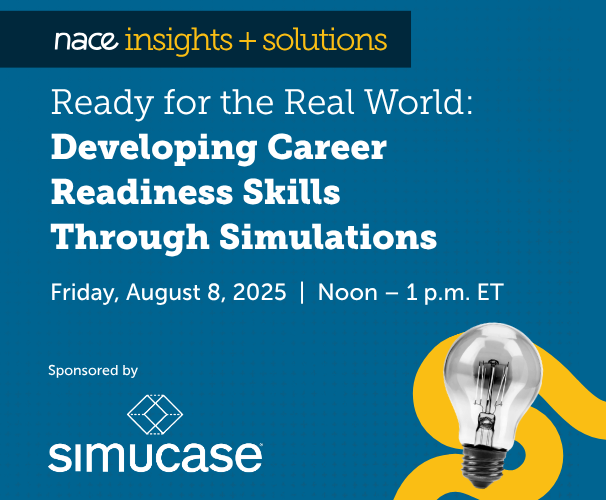The University of California – San Diego’s Rady School Career Management Center is addressing and creating resources around artificial intelligence (AI) to guide the graduate business school’s students in its effective, safest, and ethical use during the college recruiting process.
“It’s important for career offices to have at least a basic awareness of AI, how to use it, and how it is being used,” says Toni Rhorer, executive director of the Rady School Career Management Center.
“Students are tech-savvy and using GenAI, so I see our role as being able to help them harness the power of it to reduce time spent on tactical items—resumes and cover letters—so they can spend more time on high-value career work, such as decision-making, goal-setting, storytelling, networking, and more.”
It’s also prudent to make students aware of some of the pitfalls of using—or overusing—AI throughout the college recruiting process. Rhorer cites discussions amongst recruiters about how employers can tell if students are submitting applications that are solely created by AI and how this may impact students being considered for job roles.
“As the access point between student and employers,” she says, “we need to be able to share with students how recruiters are looking at this and advise them on best practices.”
Currently, in addition to creating a space on its website with resources and tips, the Rady School Career Management Center’s career coaches sometimes use ChatGPT in coaching sessions with students. For example, if a student is researching career paths, the coach may show them how to use ChatGPT to get more information on job roles within a function. Or, if a student is struggling to start a cover letter, the coach may guide them through using a prompt in ChatGPT to get started.
“We recently presented a workshop on LinkedIn, and in the discussion on the background photo, we reviewed how a student might use AI to create their own visual,” Rhorer adds.
“If we are presenting a workshop and the topic lends itself to using AI, we might do a live demonstration.”
She acknowledges that while students may be well-versed in AI, it is valuable to review its applications with them in a college recruiting context.
“Our students are very technical, and AI has been built into much of our curriculum, so a challenge we have is that students potentially know more about AI than our staff,” Rhorer says.
“We address that by making sure we are attending trainings and workshops, following key content on social media, and working with our vendors to highlight resources. In addition, we have several faculty who are experts in this area, and we tap into that knowledge as well.”
After attending several webinars, conference sessions, and meetings on AI—and encouraging her staff to take advantage of these learning opportunities—Rhorer created an AI task force to do a deeper dive and bring back information to share with the team.
“I also wanted the Rady School’s Career Management Center to produce a statement on AI usage in the career space and to develop some best practices early on. The easiest way to move quickly was to create a task force,” she says.
“The task force was led by our data and operations specialist, Stephanie Sperow. To balance the perspective, I included a career coach, Bianca Chau, and a member of our employer engagement team, Amanda Lowery. Initially, they met weekly or twice a week because I wanted to get the information on our website before the start of the fall quarter. Ongoing meetings are now held on an ‘as needed’ basis.”
The group was tasked with conducting research around using AI in career services and the job-search process and taking a look at what other schools were doing. Rhorer’s three initial goals for the task force were:
- Creating a usage statement;
- Developing a “tips sheet;” and
- Training the staff.
The first two goals were completed before fall classes started; staff training was held a couple weeks after. The usage statement the team crafted reads:
The Rady Career Management Center recognizes the value of generative AI, such as ChatGPT, as a supplementary tool for students' career journeys and encourages students to explore ways it may be useful. While generative AI has potential, it cannot replace personalized guidance, real-world insights, and holistic career planning, making career center engagement crucial for comprehensive and tailored career development.
The task force created the tips sheet to align with the career management model, which helps students understand how to navigate their career management. The tips sheet gives prompts for each phase of the model, which helps students see how they can use GenAI in each step. A vendor also produced several ChatGPT prompt/tip sheets that the center links to and conducted two webinars on the topic, which are also available through the site.
The website also features password-protected, career-specific tips for company research, company culture, salary research, and job-search acceleration, and openly available articles, such as:
- 5 Simple-ish Steps for Using ChatGPT to Write Your Accountant Resume
- I Asked ChatGPT to Write Resumes, Including Mine. Here’s What Happened
- The AI and Other Tech Tools Employers Want You to Know
Rhorer says involving others on campus—particularly faculty—in efforts to grasp how students are using AI and what technologies they work with is important. For example, before the Rady School Career Management Center task force created its statement on using AI in careers, a faculty member shared a document that highlighted all the usage statements each faculty member had on their syllabus.
“This helped us make sure our statement was aligned to the broader usage at the school,” Rhorer explains.
In addition, the Master of Science in Business Analytics at Rady has integrated AI into its entire curriculum and all students were given the advanced version of ChatGPT, which she says is helpful for the Rady School Career Management Center team to know as they are coaching students.
“I try to remember that we don’t have to be experts on AI to help students use it,” Rhorer says.
“It is not our role to train students on AI, but rather to help them understand how to apply AI in the career process in a way that enhances and amplifies the work, as opposed to replacing it.”







